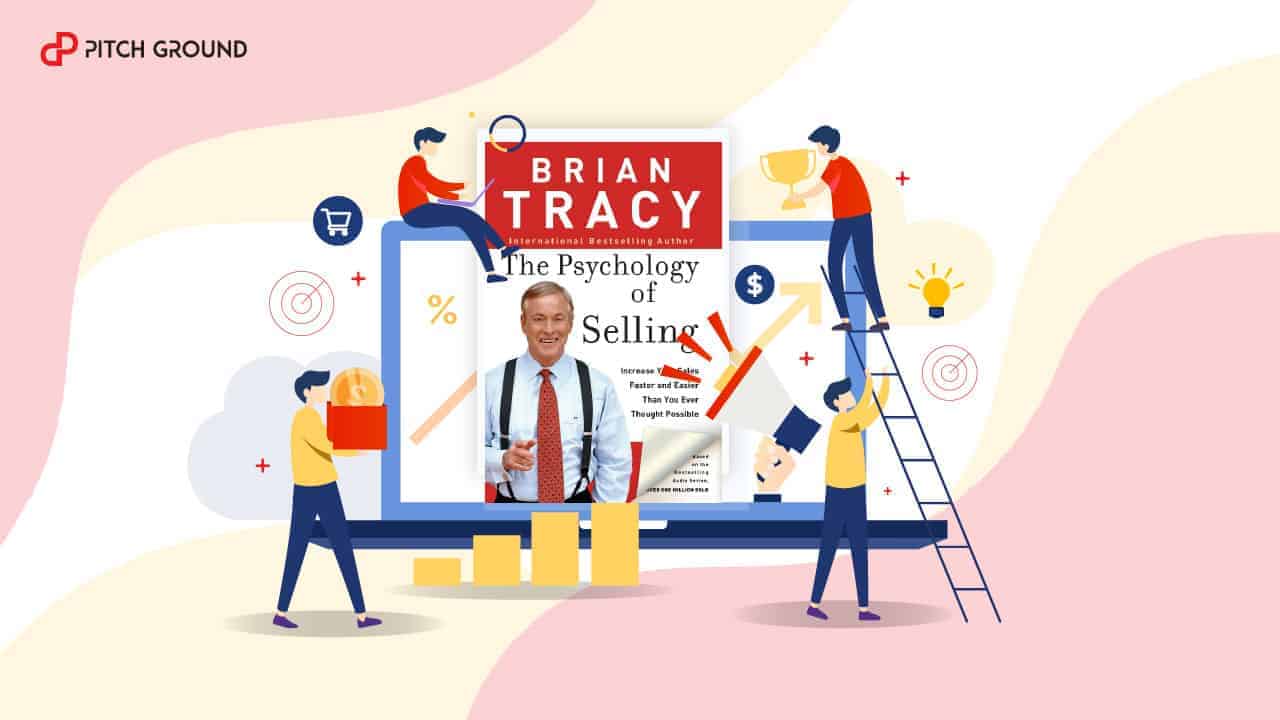Who doesn’t know about the legendary sales professional Brian Tracy? His proven techniques & strategies for great success in sales, time management, and self-development are known worldwide.
His book “The Psychology of Selling: Increase Your Sales Faster and Easier Than You Ever Thought Possible,” is a comprehensive and exhaustive guide on the art of selling.
In any organization, the sales department plays a very prominent role in ensuring the success of the business. Be it business development or revenue generation, and effective selling lays the foundation.
In this book, Tracy explains that salesperson is the most important for any business.
Here’s a quick summary of this book for you to understand his concepts better:
The Inner Game of Selling
Tracy pointed out that “Without sales, the biggest and most sophisticated companies shut down.”
And there is nothing in it to disagree. Tracy says that 80/20 rule cleared a lot of doubts for him, initially in his career.
The Psychology of Selling: The “80/20 Rule”
The Pareto principle (also known as the 80/20 rule) when applied to sales, turns out that, “The top 20% of salespeople make 80% of the money, and the rest 80% at the bottom only derives 20% of the money from customers.”
So, you need to strive hard to become a member of the top 20%. A little modification in your sales technique will enhance your performance, thereby revenue.
Tracy swears by the “winning edge concept” which states: “Small differences in ability can lead to enormous differences in results.”
Therefore, to achieve mind-blowing results and break into the top 20% of salespeople, make a little effort to get better than your competition. In fact, not only internal but take external factors also into account.
Fortunately, the skills required to be a great salesman are not hard to acquire. Stop grasping at straws and look here at the required skills that can get you a place in the top 20% of salespeople:
- Prospecting- It includes identifying the needs, demands and wants of the potential clients.
- Building Rapport- Get information by prospects by asking them the right defined questions. It helps you to build rapport with the customer, thereby making it easy for you to identify his needs.
- Presenting- As it goes, ‘The first impression is the last impression.’ So make impactful sale presentations and make an excellent first impression.
- Handling Objections- Respond persuasively to any of the objections and learn to distinguish facts from opinions clearly.
- Closing the sale- Don’t restrict yourself. Use different methods for closing a sale and focus on building a long-term collaboration with your customers.
- Resales and referrals- Ultimately focus on getting referrals to acquire new customers and on resales to boost your sales and revenue.
“Fear of failure” and “fear of rejection” are two issues usually faced by salesman while closing a deal.
Let’s take it this way; if you fear to fall, you’ll never learn how to ride a bicycle. Dealing with rejection is not easy, but then rejection in sales in a common phenomenon.
Don’t take rejection too personally. Take it in your stride, enhance self- esteem and find creative ways to break through walls and barriers to achieve sales success.
To explain this better, Tracy states that a salesperson’s “self-concept” is vital to success.
Self-concept is more of like self-belief. It is the way you think about yourself. For a salesperson to excel in his field, a positive self-concept is a key.
There is a direct relationship between your self-concept, on the one hand, and your performance and effectiveness, on the other. Every day is full of opportunity, and your pipeline will likely stay full.
“If you see yourself making $50,000 a year, you’ll be in the comfort zone of just earning $50,000. However, if you expand your targets to $100,000 a year, your behaviors will change accordingly to strive toward the goal.
Decide your worth an don’t self-limit yourself. However, in the beginning, be realistic while deciding your self-concept. Unrealistic targets demotivate, instead of motivating.
Tracy says that “Successful people control their inner dialogues,” So, to be successful having successful thoughts is crucial.
Take every day as a new day full of opportunities and strive hard to give your best. Achieve your goals in mind before you achieve them in reality.
Setting And Achieving Sales Goals
Are you setting career goals?
As a salesperson, you have to rely on the incredible power of goal setting and strategic planning. A detailed, written road map to get your final destination is the key.
Tracy says that the quality of goals is in direct proportion to your levels of success. A powerful way to help you think and make better decisions is setting quality goals.
Salespeople should set goals in the following areas:
- Annual income goals- Determine your yearly income and sale goals. Decide precisely how much money you want to earn in the coming year. You can start by taking your highest gross income year to date and increase that number by 25 percent to 50 percent. In case you are more ambitious to achieve your goals, increase that percentage a bit.
- Annual sales goals- They are in direct proportion to how much income you want to make. Your selling goals as per how much income you want to earn.
- Monthly weekly, and daily goals- Now, break them down by month, week, and day. For example, if your annual income goal is $72,000, then your monthly income goal is $6,000. If your monthly income goal is $6,000, and let’s say you work fifty weeks per year, then you earn $1,440 each week, and $288 per day, if you work five days a week.
- Activity Goals or desired hourly rate- Now based on your income goals, determine your desired hourly rate. Once you have to fix it, you refuse to do anything during the day that does not pay you your desired hourly rate or more than it. So you’ll set your activity goals following the money you need to make.
- Personal Goals- Introspect yourself that why are doing a particular task and strive for self-motivation.
Tracy says that prepare a list of everything, at least 100 goals you’d like to accomplish, to achieve all your career goals. Organize the list in terms of value and priority. Visualize yourself achieving these goals.
If you visualize prospects responding positively to your selling techniques, a sense of success starts prevailing. Then, decide what you can do and underline the activities that are crucial for reaching those objectives.
Why People Buy
The main funda here is that customers are more interested in knowing the intent behind your plans, I.e., what your ideas will do for them rather than what they are.
Their decisions are in proportion to improvement. If they feel that your product will change their life for better, they will choose it over a competitor’s product.
It takes continuous effort to maintain high customer satisfaction levels. Tracy says that different people have different degrees of satisfaction.
Therefore, different approach or actions are needed to satisfy different people. Experienced salespeople, of all kinds, always talk about how their idea will benefit the customer in his present situation.
In sales, always remember that you must sell unto others in terms of what they want and need, and not about what you want and need.
“Every decision is emotional.” Thereby identify the prospect’s emotional values. Previous emotions create preferences which influence the decision. Therefore, emotions should be of prime importance to salespeople.
Just determine which emotional lever to pull, and how your product/service fulfills those emotional values.
Choosing which emotion to focus on depends on your buyer’s personality. People consider a lot of things before they make a purchase.
They think about the reactions of their manager, colleagues before making a purchase. So, modify your sales approach accordingly.
Experienced salespeople understand the value of these emotions. Only inexperienced salespeople focus on price and quality as if these features will convert the prospects.
These are never the main reason to buy, so don’t make them of primary concern.
Tracy says that “The two primary motivations for making – or not making – a purchase are “desire for gain and fear of loss.” The desire for gain is seeking improvement.
People feel a certain kind of advancement with the product. Prospects worry about the fear of loss.
The fear of loss crops up when prospecting concerns about making a mistake when they think that the goods or services they are purchasing will be of no use to them.
Every buying decision comes down to specific needs. Everyone has certain basic human needs that serve as motivation to take buying action.
Identify which need is the right one to appeal to and choose the one based on your offering. Convince your prospect that your product or service will meet the requirements in the best possible way.
Sound so convincing that to fulfill their needs, there is nothing better in the market than your product. Here are some primary customer needs:
- Money- Money is always a top motivator in consumer behavior. Money and rewards motivate all. Emphasize on their benefits and tell them the return on investment in monetary forms. If you can by any way link your products or services on making or saving money for the customer, he’ll surely pay heed to whatever you say.
- Security- It is a fundamental need. Having sufficient money gives a sense of security to people. Security is a very personal concept, and people always seek more and more of it.
- Being Liked- Who doesn’t want to be liked by others? Everyone seeks admiration from friends, neighbors, and relatives. Customer satisfaction comes from the fact that that if they purchase your product, others will like them.
- Status And Prestige- Everyone wants to satisfy their ego. As customers, we want people to praise our accomplishments. People need to feel important and valued to others.
- Health And Fitness- This has become a hot selling topic these days. People easily get attracted to products and services that enable them to be thinner and ensure a healthy lifestyle.
- Praise And Recognition- In other words, buying desire. The Sellers of luxury cars or expensive items uses this kind of approach. Its all about convincing your prospect that he will achieve greater recognition or status by using your product.
- Power, Influence, And Popularity- When your product instills the feeling of being influential and popular among others, there come buying motivation in people.
- Leading The Field- Everyone wants to win the rat race. People want to stay updated and modern. To be ahead of the pack, people will buy if you offer any newest product in the market.
- Love And Companionship- By making the prospect feel desirable as a companion, helps to arouse an immediate buying desire.
- Personal Growth- Remember Maslow’s self- actualization needs? People want to feel that they are becoming all that they are capable of becoming. Promoting your products in the same lieu that can help people reach even greater heights of personal success and self-realization, will motivate them to buy.
- Personal Transformation- If a prospect feels that your products and services will provide improvement in his current scenario, and make them a different person in some way, they will not hesitate to spend. It is the highest category, and customer satisfaction is greatest here.
By knowing these 11 consumer needs, you will be able to identify your prospect needs better and sell it in the right way.
Your level of Creativity in Selling
Some companies, sell better than the other, despite having similar products. One of the main reason behind it is their difference in creativity to sell.
However, Tracy feels that your level of creativity is mostly determined by your self-concept, by how you think and feel about yourself. For example- To avoid traffic jam to reach on time, you take other roads or alleys.
It is a great creative way to solve the problem. Your beliefs become your reality. But to help you out, here are Three Ways To Stimulate Creative Thinking:
- Have clear goals
- Ask focused questions
- Solve pressing problems
You should use all three of these continuously, to keep your mind functioning at its highest level. In selling, there are several areas where you can increase your creativity with regular practice.
The first one is prospecting, and the other one is uncovering buying motives. These areas are a real test of your intelligence and brainpower.
If you don’t know what your prospects want, you’ll never be able to convince them.
As per Tracy Four principles of marketing strategy are
1. Specialization- Determine where you will specialize
2. Differentiation- Why are different. Having a competitive advantage over the other
3. Segmentation- Who are the specific customers in the market
4. Concentration- Where you want to focus all your energy and efforts.
Read, study, and memorize your product information. Brainstorm as many ideas as possible because your imagination only limits better prospects.
Be creative in questioning and use your creativity to overcome buyer resistance.
How to Get More Appointments
The six most essential words in selling are: “Spend more time with better prospects.” But then, the main question is that once you find better prospects, how to make the time count?
Or in simple words, how to spend more time with better prospects.
- Break prospect preoccupation- Break the preoccupation of the prospect by asking a good question aimed at the result or benefit of your product. Everyone you call on might be busy with many other things. So, make sure to break through this preoccupation with your opening words, unless you won’t get a chance to make your sales presentation.
- Sell the appointment, not the product – While telephoning sell the appointment and not the product. Avoid talking about your product or pricing on the phone unless you can make and conclude the sale without seeing the prospect personally.
- Watch your words- The prospect might be busy with various things when you place a call. Your opening line should be equivalent to throwing a brick going through their window. The opening statement should not be about the product or service; it should be the one that benefits the prospects.
You have only 30 seconds at the beginning of your meeting to catch your prospect’s full attention. Observe the prospecting methods that your company’s top salespeople use and apply them to your practice.
The Power of Suggestion
Human beings get significantly influenced by suggestive elements, especially the human elements. A calm, confident and relaxed salesperson is convincing.
Top salespeople look professional in every aspect and have a soothing effect on customers. In your suggestive environment, you are likely to be more influenced by the people you deal with regularly.
You can control your internal environments- like your appearance, voice, and attitude. Here are some more ways:
1. Be positive and cheerful
2. Practice your selling
3. Dress for success
4. Pleasant surroundings
5. Groom yourself well
6. Upgrade your offices
7. Work from a clean desk
8. Double your productivity
When you look like a total professional and organize your presentation well, the customer confidence in you increases.
Walk the talk, shake hands firmly and thoroughly, be well-dressed and well-groomed, sit erect, facing forward and minimize any interruptions during the meeting, to garner the full attention of your prospect.
Making the Sale
Encountering resistance in sales is normal. To neutralize sales resistance, tell your prospects that you understand the issue behind their resistance and counter with social proof, and tell them the benefits of your product or service. First of all, believe in your product.
- The Approach Close- You use this right at the beginning of the sales presentation. The primary purpose is to get the prospect to agree to decide after you’ve made your presentation.
- To overcome this natural resistance at the beginning of the sales conversation, say this. “Mr. Prospect, I’m not here to sell you anything right now. All I’m going to do is to show you some of the reasons why people have bought this product, and continue to buy it over the years. Listen with an open mind and then make your decision about whether it suits you or not”.
- The demonstration close- Another effective closing technique that you can use, right at the beginning, is called the demonstration close. Change the focus of your discussion as per the busying capacity of your prospect. For example- Start the conversation with “Mr. Prospect, if I could show you the very best investment you’ve ever seen, how much you can invest?” The discussion is no longer about whether or not the prospect listens to your presentation. It is about how much he can invest.
Every buyer has a different personality. It’s essential to understand each one of them:
- The apathetic buyer- These are negative kind of people who are never going to buy. Don’t waste your time on them.
- The self-actualizing buyer- They know what they want exactly and how much they are willing to pay for it. Make the most out of them. They already have set specifications in mind, so don’t try to sell them anything else.
- The analytical buyer- All they care about is details. Be precise and exact with these prospects. They don’t make decisions in a hurry. So slow down your selling approach.
- The relater buyer- They like to develop a relationship and when buying their concern is the impact of the product on other people. To make a sale, tell them about other happy customers.
- Socialized buyer- This type of prospect is straightforward, right to the point. Kind of business deal, just put everything on paper, once you make a deal.
Understand your buyer’s personality and tailor your approach accordingly. Use open-ended questions and seek clarification, if any.
10 Keys to Success in Selling
To help you to improve continuously, here are Brian Tracy’s ten keys to success in selling:
- Top Salespeople Do What They Love To Do- Love your work and then commit yourself to become excellent in your field.
- Decide what you want- Set your goals and then determine what price you can pay for it.
- Back your Goals With Perseverance- Put your whole heart and soul in achieving your sales career goal.
- Commit to lifelong learning- Never stop learning new techniques.
- Use your time well- How you use your time determines your standard of living.
- Follow the leader- Follow the leaders, not the followers. Do what other successful salespeople in your company do.
- Character Is Everything- You can be successful only if people trust you.
- Use your Inborn Creativity- Recognise your ability to do more and be more
- Practice the golden rule- Think about yourself as a customer, and then use the same approach on your customer.
- Pay The Price Of Success- Don’t waste your time and work harder.
Conclusion
This book gives remarkable insights into day-to-day sales fundamentals. Read this to improve your sales career to become one of the highest-earning salespeople in your company.



